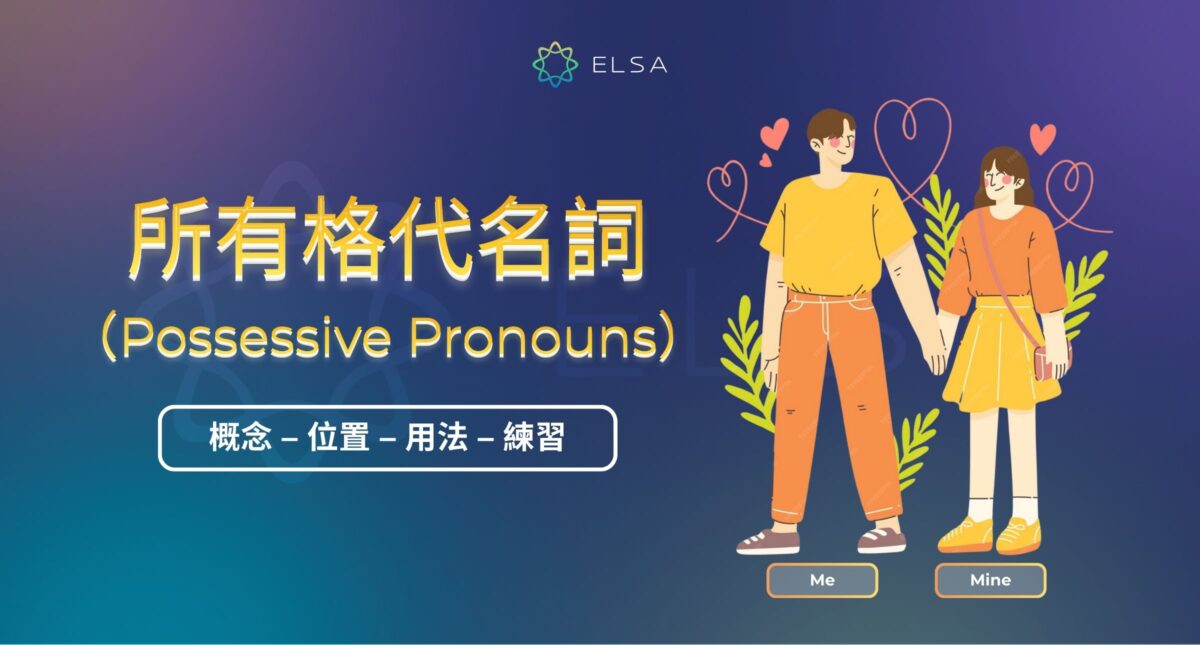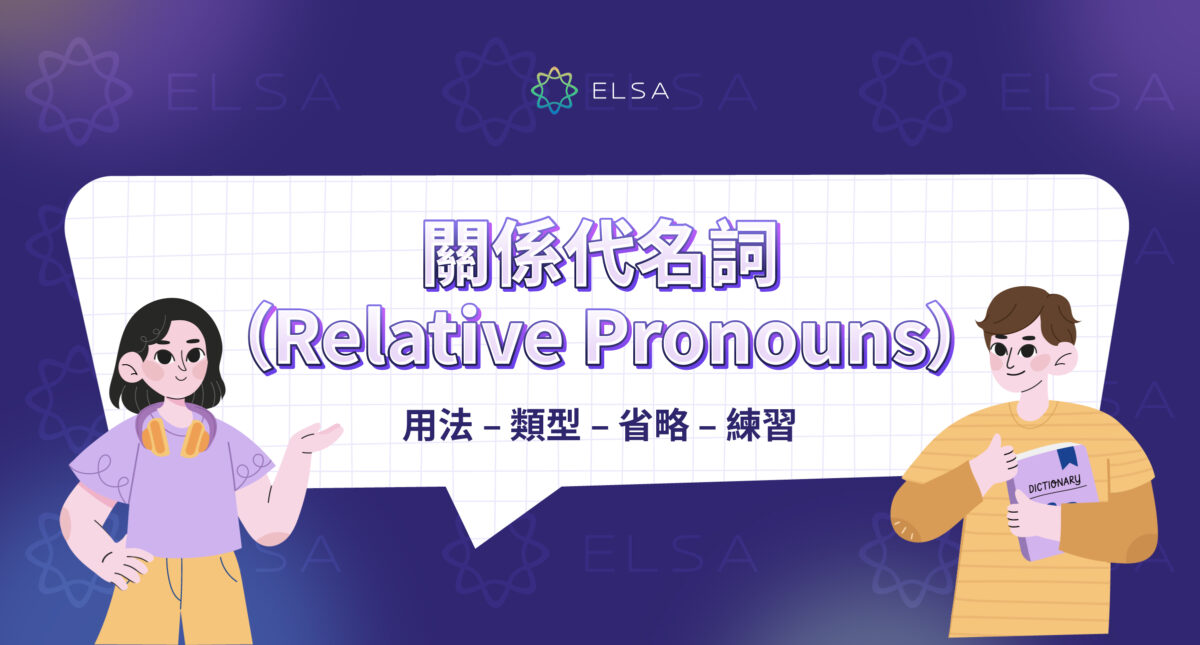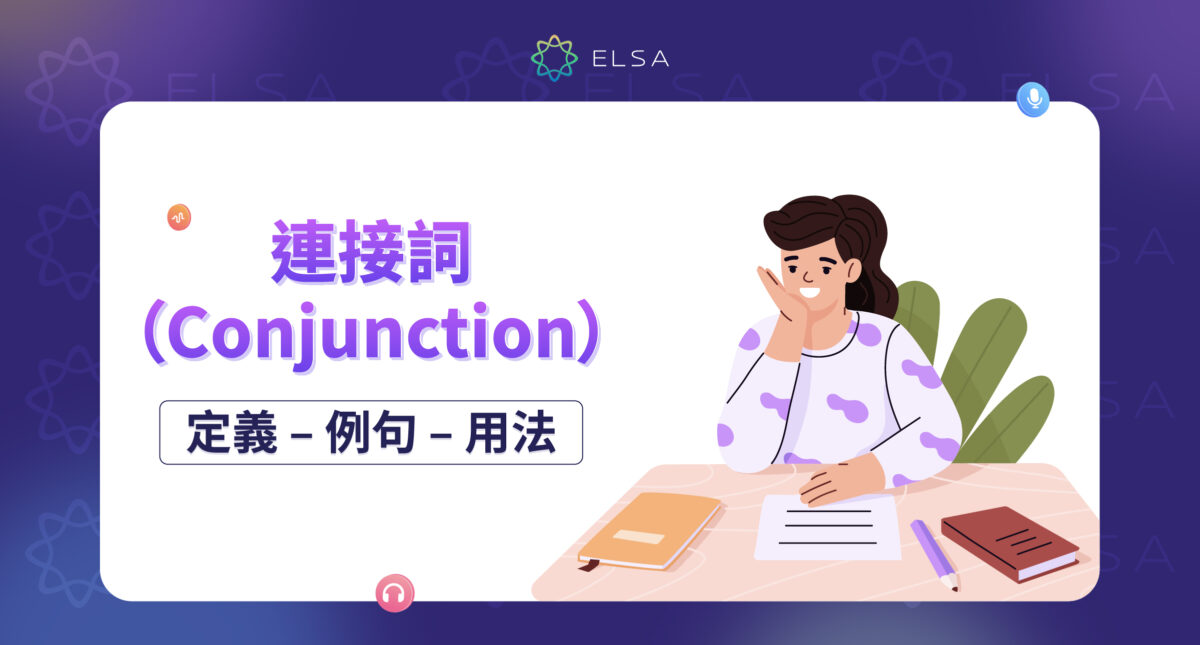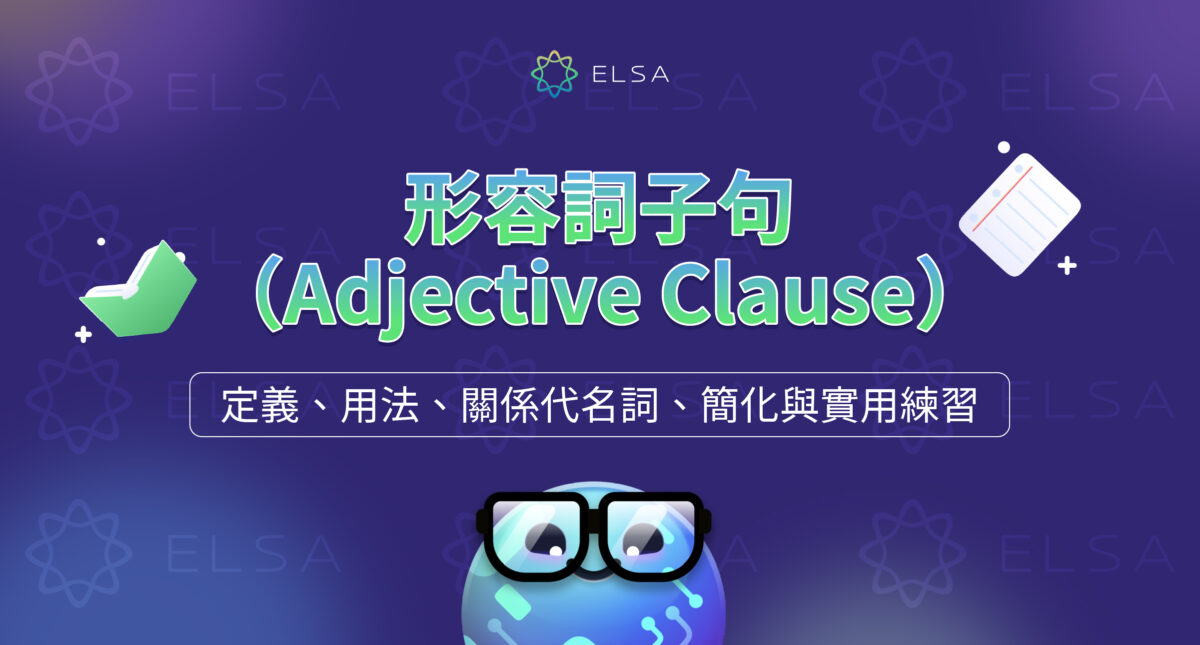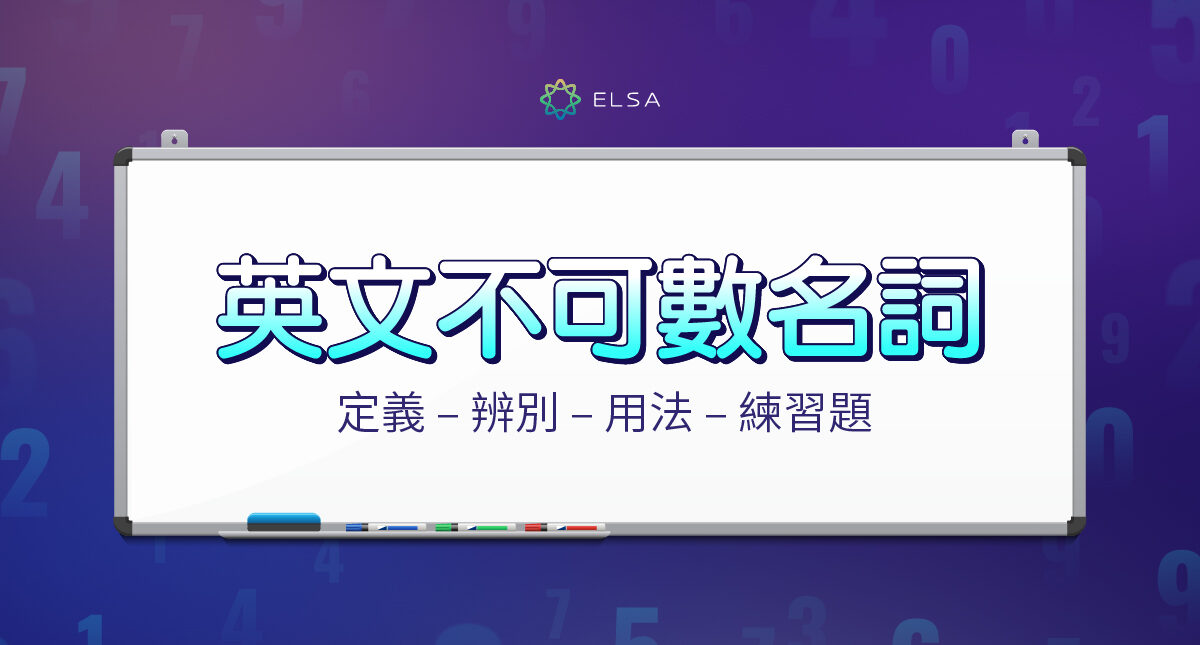與 ELSA Speak 學習過去分詞英文:定義、用法、常用過去分詞表、簡單易懂的例句。此外,你就學會過去分詞過去式的差別,以便在日常寫作和口語中正確運用。
過去分詞是什麼?
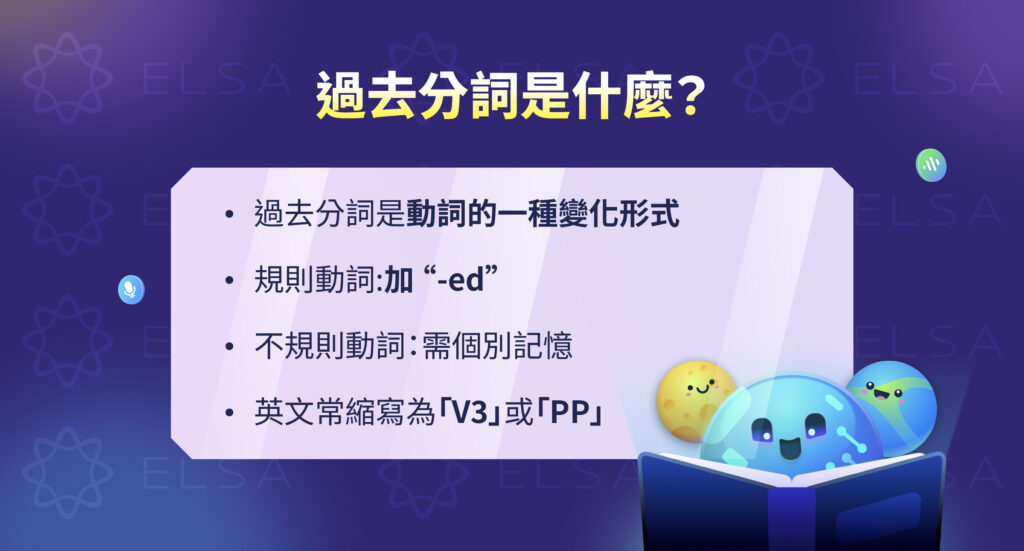
在過去式 過去分詞 (Past Participle)動詞的形式加上後綴“-ed” (用於規則動詞)和其他變化(用於不規則動詞)。
一些過去分詞例句例子:
- I finished my homework last night. (我昨晚完成了作業。)
- No one believed that I graduated from NTPU with a good degree. (沒有人相信我以優異的成績從NTPU畢業。)

如何構成過去分詞?
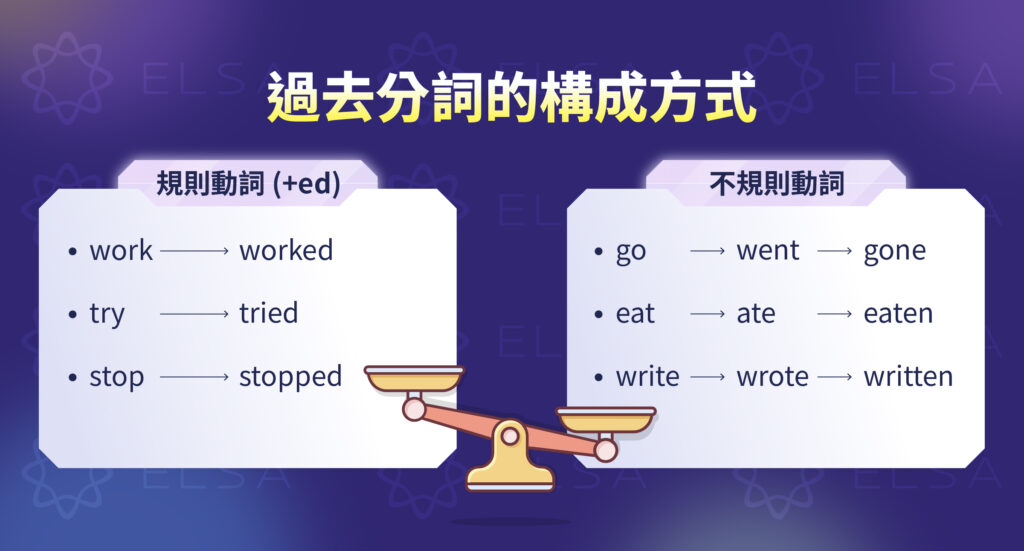
在常規動詞中加上“-ed”
對於規則動詞,過去分詞是在動詞末尾加上後綴“ed”形成的。
例子:
- Work → Worked
- Wish → Wished
在添加後綴“-ed”時,需要注意以下幾種情況:
| 過去分詞變化規則 | 範例 |
|---|---|
| 以 2 個韻母 + 1 個聲母或 2 個聲母結尾的動詞 → 加 –ed | need (需要) → needed seem (好像) → seemed kick (踢) → kicked call (打) → called |
| 以 -e 或 -ee 結尾的動詞 → 只要加 -d | wave (揮) → waved agree (同意 → agreed smile (笑) → smiled |
| 以聲母 + y 結尾的動詞 → 在加上 –ed 之前將 y 變成 i | try (努力) → tried dry (弄乾) → dried study (學習) → studied |
| 以韻母+聲母結尾的單音節動詞 → 在加-ed之前雙寫聲母(以-w、-x、-y結尾的動詞無需雙寫) | stop (停) → stopped fit (合適) → fitted flex (秀)→ flexed play (玩) → played |
| 以韻母 + 聲母結尾的多音節動詞,重音在最後一個音節 → 雙寫聲母然後加上 –ed | prefer (更喜歡) → preferred regret (後悔) → regretted commit (承諾) → committed |
| 以韻母 + -L 結尾的多音節動詞 → 在加 -ed 之前雙寫 -L(美式英語中,如果重音不在最後一個音節上,則不雙寫 -L) | travel (旅行) → travelled control (控制) → controlled |
| 以 -c 結尾的動詞 → 在加 -ed 之前加上 k | traffic (交通) → trafficked mimic (模仿) → mimicked picnic (去野餐) → picnicked |
不規則動詞過去分詞表
不規則動詞在變成過去分詞時沒有任何規則。因此,掌握這些不規則動詞的唯一方法就是記憶和經常練習。
以下是常見不規則過去分詞表,供你參考:
| 原體 (V1) | 過去 (V2) | 過去分詞 (V3) | 意思 |
|---|---|---|---|
| be | was/were | been | 是,在 |
| become | became | become | 變得 |
| begin | began | begun | 開始 |
| break | broke | broken | 弄破 |
| bring | brought | brought | 帶來 |
| build | built | built | 建築 |
| buy | bought | bought | 買 |
| catch | caught | caught | 抓 |
| choose | chose | chosen | 選 |
| come | came | come | 到 |
| do | did | done | 做 |
| drink | drank | drunk | 喝 |
| drive | drove | driven | 開車 |
| eat | ate | eaten | 吃 |
| fall | fell | fallen | 摔倒 |
| feel | felt | felt | 覺得 |
| find | found | found | 找到 |
| fly | flew | flown | 飛 |
| forget | forgot | forgotten | 忘 |
| get | got | gotten/got | 得到 |
| give | gave | given | 給 |
| go | went | gone | 去 |
| have | had | had | 有 |
| hear | heard | heard | 聼 |
| keep | kept | kept | 保持 |
| know | knew | known | 知道 |
| leave | left | left | 離開 |
| lose | lost | lost | 失去 |
| make | made | made | 做/製作 |
| meet | met | met | 見 |
| pay | paid | paid | 付錢 |
| read | read /red/ | read /red/ | 讀 |
| run | ran | run | 跑 |
| say | said | said | 說 |
| see | saw | seen | 看見/看 |
| sell | sold | sold | 賣 |
| send | sent | sent | 寄 |
| sing | sang | sung | 唱 |
| sit | sat | sat | 坐 |
| sleep | slept | slept | 睡覺 |
| speak | spoke | spoken | 説話 |
| stand | stood | stood | 站 |
| swim | swam | swum | 游泳 |
| take | took | taken | 拿 |
| teach | taught | taught | 教 |
| tell | told | told | 告訴 |
| think | thought | thought | 想 |
| understand | understood | understood | 懂 |
| wear | wore | worn | 穿 |
| win | won | won | 贏 |
| write | wrote | written | 寫 |
>>參考此文了解更多:動詞三態是什麽? 動詞三態的區別和最準確的用法。
過去分詞用法
完成式的過去分詞

過去分詞通常用於完成式。具體是現在完成式、過去完成式和未來完成式。
現在完成式結構:
| (+) S + have/has + V3/-ed (Past Participle) (-) S + have/has + not + V3/-ed (?) Have/Has + S + V3/-ed + …? |
例子:
- My English has improved a lot thanks to using ELSA Speak. (通過使用 ELSA Speak,我的英語水平提高了很多。)
- She has not finished her homework. (她還沒有完成作業。)
- Have you been to Paris? (你去過巴黎嗎?)
>>相關内容:現在完成式 (Present Perfect): 公式、用法和應用練習
過去完成式結構:
| (+) S + had + V3/-ed (-) S + had + not + V3/-ed (?) Had + S + V3/-ed + …? |
例子:
- I had finished my homework before I went to bed last night. (昨晚睡覺前我已經完成作業了。)
- My sister hadn’t washed the dishes when my mother came home. (當我媽媽回家時,我姐姐還沒有洗碗。)
- Had you finished your work before the meeting started? (會議開始前你的工作做完了嗎?)
>>相關内容:過去完成式 (Past Perfect): 理論與練習
未來完成式結構:
| (+) S + will/won’t + have + V3/-ed (-) S + will/won’t + not + have + V3/-ed (?) Will + S + have + V3/-ed + …? |
例子
- She will have finished this book before 10 o’clock this evening. (她在今天晚上10點前將完成這本書。)
- She won’t have finished the project by tomorrow. (到明天她還無法完成這個計畫。)
- Will they have left by the time we get there? (當我們到達那裡時他們已經離開了嗎?)
>>了解更多英文時態:12 種英文時態:結構、識別標誌、用法、記憶技巧與應用練習
過去分詞形容詞的用法

過去分詞在句子中也用作形容詞。過去分詞形容詞描述一個人因某件事或事件而產生的感受或情緒。
例子:
- My brother is interested in that book. (我弟弟對那本書很有興趣。)
- My mother is tired of her work. (我媽媽對工作感到厭倦。)
用於被動句
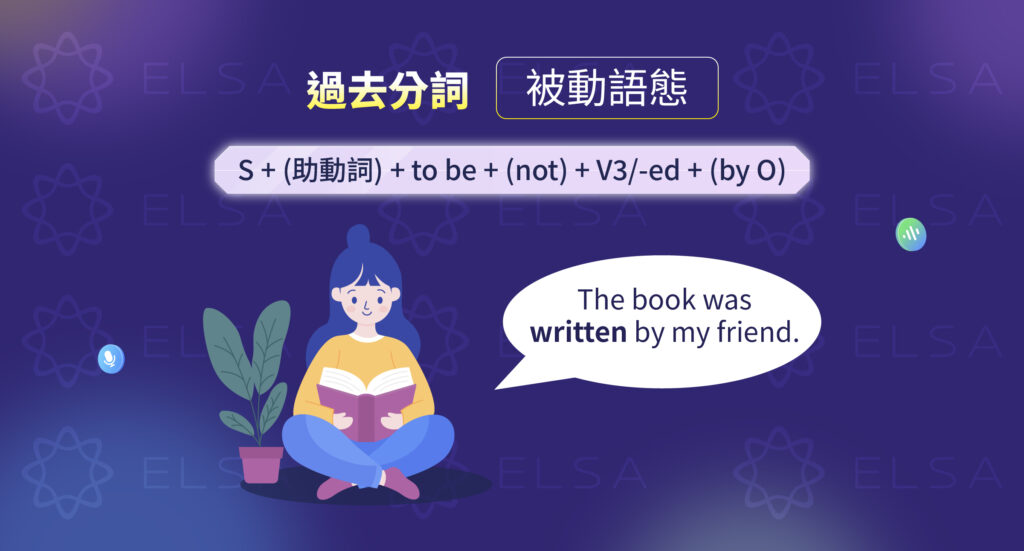
被動句是一種主詞為受某一個對象影響的人或事物的結構。
結構:
| S + (輔動詞) + to be + (not) + V3/-ed + (by O) |
例子:
- The book was written by my brother last week. (這本書是我哥哥上週寫的。)
- The food has been cooked by professional chefs. (食物均由專業廚師烹調。)
>>相關内容:被動語態是什麽?探索公式、結構和註釋以及應用練習,以避免混淆
用於簡化的被動關係子句

除了上述用法外,當子句為被動形式時,過去分詞也用於減化關係子句中。
結構:
| …Noun/Noun phrase +關係代詞+ be + V3/-ed… ⇒ …Noun/Noun phrase + V3/-ed… |
例子:
- The car that was parked in front of the house is mine. (停在家門前的那輛車是我的。)
→ The car parked in front of the house is mine.
- The shirt which was sold last week is Jane’s favorite. (上週賣掉的襯衫是簡最喜歡的。)
→ The T-shirt sold yesterday is Linh’s favorite.
用於第 3 類條件句
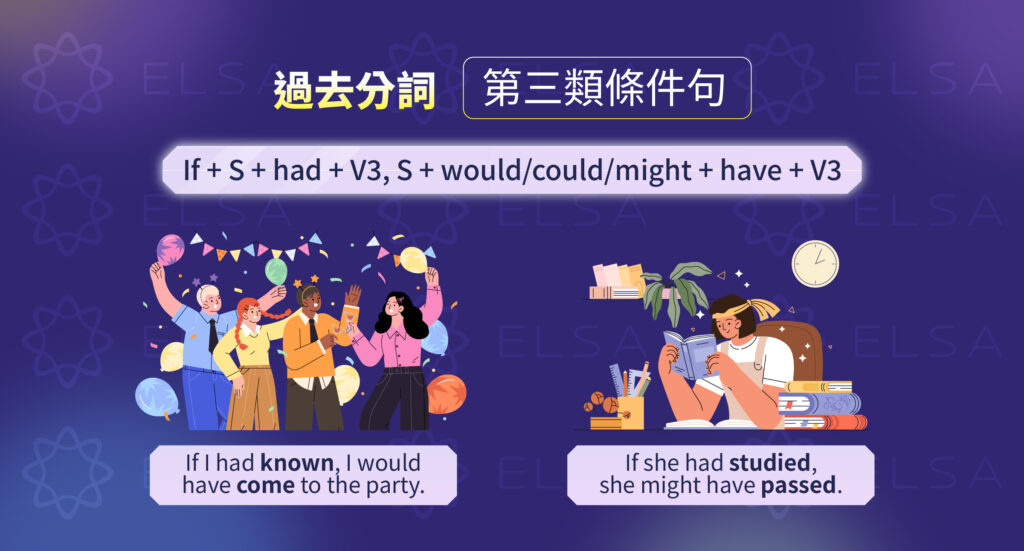
過去分詞可用於第三類條件句,用於陳述過去不可能發生的事件或現象,通常包含不切實際的假設。
結構:
| If + S + had + V3/-ed, S + would/could/might + have + V3/-ed .. |
例子:
- If I had known it was going to rain, I would have taken an umbrella. (如果我知道會下雨,我就會帶一把傘。)
- If they had studied harder, they would have passed the exam. (如果他們更努力學習,他們就會通過考試。)
>>相關内容:If 用法,概念,結構與練習: 一、二、三,混合
帶有能願動詞+ “have” (perfect modals)
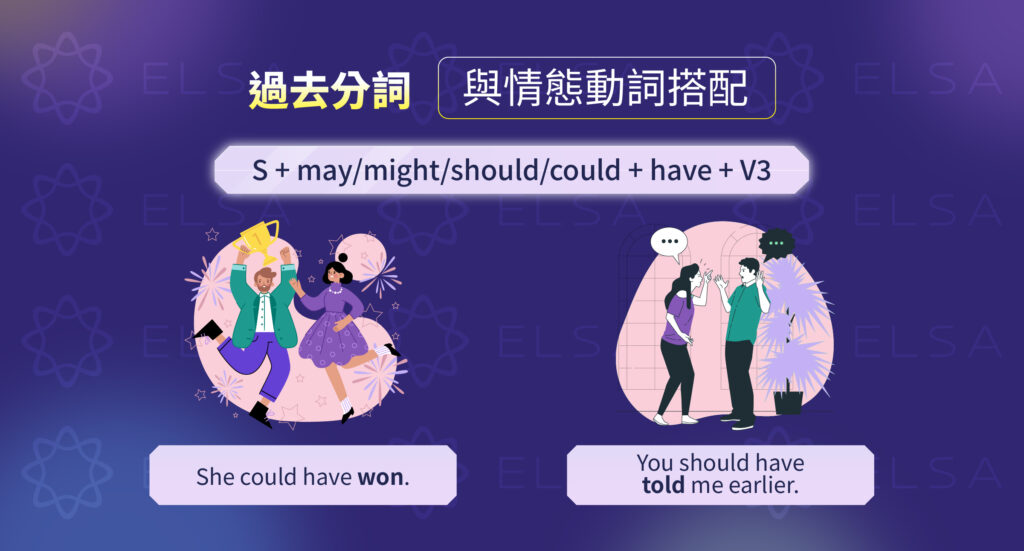
過去分詞後接能願動詞+”have” (perfect modals) 用於表達過去可能發生,但因某種原因而沒有發生的動作或事件。
結構:
| S + 能願動詞 + “have” + V3/-ed |
例子:
- She could have finished the project earlier. (她本來就可以早點完成這個專案。)
- We should have called you before coming. (我們來之前就應該打電話給你。)
區分過去分詞與英語中的其他語法結構
過去式過去分詞差別
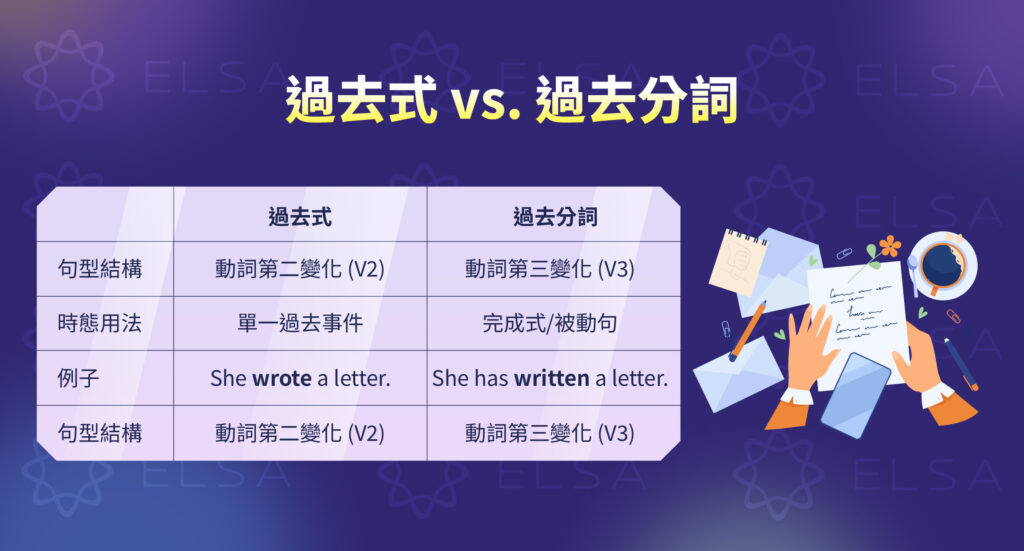
| 一般過去式 | 過去分詞 (Past Participle) | |
|---|---|---|
| 形式 | – 規則動詞:加-ed – 不規則:形式 2 (V2) | – 規則動詞:加-ed – 不規則:形式 3 (V3) |
| 例子 | walked, ate, went, did | walked, eaten, gone, done |
| 用法 | 描述過去發生的動作 | – 用於完成式 – 是形容詞 – 用於被動句 |
| 句子中的位置 | 在過去式的主詞之後:He went home. | – have/has/had 之後: He has gone home. – be 之後(被動): It was broken. |
| 用的是哪一種時態? | 一般過去式 | – 完成式 – 被動式 – 簡化被動結構,形容詞 |
| 特別說明 | 不與have/has/had使用 | 不單獨表達過去的行為 |
現在分詞和過去分詞的區別
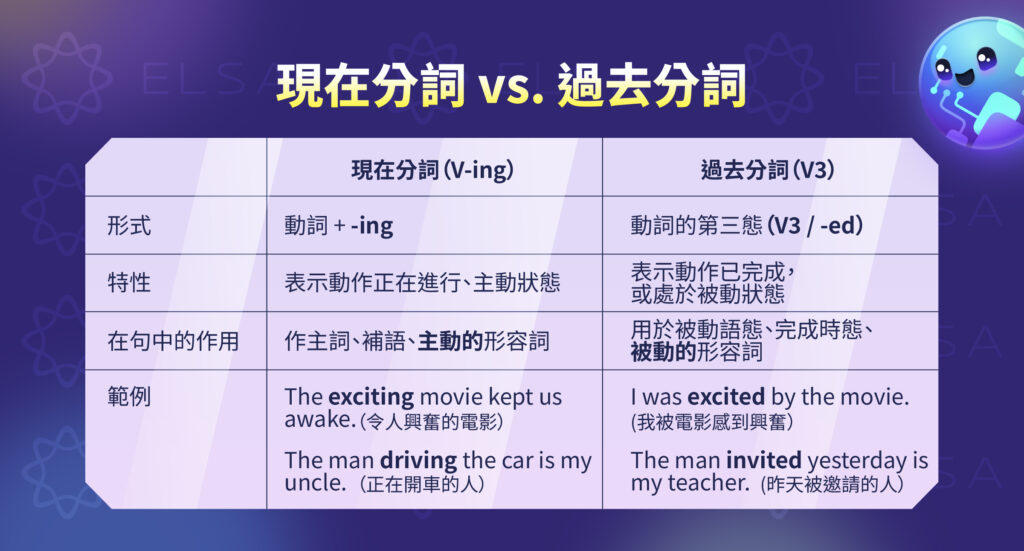
| 現在分詞 (V-ing) | 過去分詞 (V3/ed) | |
|---|---|---|
| 形式 | 動詞 + -ing | 動詞形式 V3 或加 -ed(用於規則動詞) |
| 性質 | 描述正在進行且主動的動作。 | 表達已完成或被動的動作 |
| 主要用法 | – 用作主詞、賓語、補語 – 用於簡化子句(主動語態) | – 用於被動句,完成式 – 用作形容詞– 被動式簡化子句 |
| 例子 | – Reading books is my hobby. – The boy singing is my friend. – I saw him running. | – The book written by her was amazing. – He has finished his homework. – The gift sent yesterday is from my aunt. |
過去分詞練習
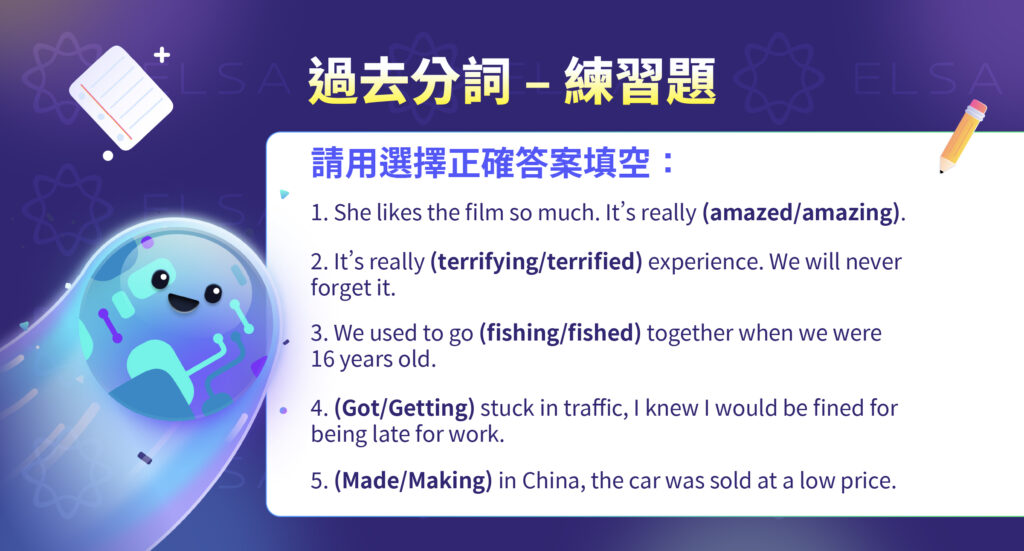
練習
練習 1: 選出正確答案
- She likes the film so much. It’s really (amazed/amazing).
- It’s really (terrifying/terrified) experience. We will never forget it.
- My brother reads a (fascinated/fascinating) book. It made him (surprised/surprising) at the immigrants.
- People easily (embarrassed/embarrassing) when we can’t express ourself well in USA.
- During the first few years, many immigrants feel (hindering/hindered) by their slow economic advancement.
- My sister felt (disappointed/disappointing) very when her visa to England was denied.
- We used to go (fishing/fished) together when we were 16 years old.
- Many baseball players from the US (excited/excited) when they are selected to play for their National team.
- (Got/Getting) stuck in traffic, I knew I would be fined for being late for work.
- (Made/Making) in China, the car was sold at a low price.
練習 2: 用現在分詞或過去分詞重寫句子
1. A beautiful girl was sitting next to me on the train. I don’t talk to her much
→ I didn’t talk much to the …………………………………………………..
2. A taxi was taking my family to the airport. It was badly damaged.
→ The …………………………………………………..
3. There is a shop at the end of this street. That shop sells very good Korean food.
→ At the end of the street there’s a …………………………………………………..
4. A factory has just opened in the town. It employs 250 people.
→ A………………………………………………….. has just opened in the town.
5. The company sent me a brochure. It contained important confidential information..
→ The company sent me …………………………………………………..
答案
答案 1:
| 句子 | 1 | 2 | 3 | 4 | 5 |
| 答案 | amazing | terrifying | fascinating | embarrassed | hindered |
| 句子 | 6 | 7 | 8 | 9 | 10 |
| 答案 | disappointed | fishing | excited | getting | made |
答案 2:
- I didn’t talk much to the beautiful girl sitting next to me on the train.
- The taxi taking my family to the airport was badly damaged.
- At the end of the street there’s a good Korean food
- A factory employing 250 people has just opened in the town.
- The company sent me a brochure containing important confidential information.
常見問題
過去分詞是動詞嗎?
→ 過去分詞是動詞的一種形式,而不是單獨的動詞。
have 過去分詞是什麼?
→ “have” 的過去分詞是 had.
過去分詞是 V2 還是 V3?
→過去分詞是 V3。
希望通過本文,你能更理解過去分詞,了解如何正確使用過去分詞的語法,以及如何將其與一般過去式區分開來。繼續通過例句和不規則動詞表練習,以加深記憶。掌握這些知識將為你在各種情況下更自信、更準確地使用英語奠定堅實的基礎。別忘了關注 ELSA Speak,以獲得更多關於英語文法的新知識!

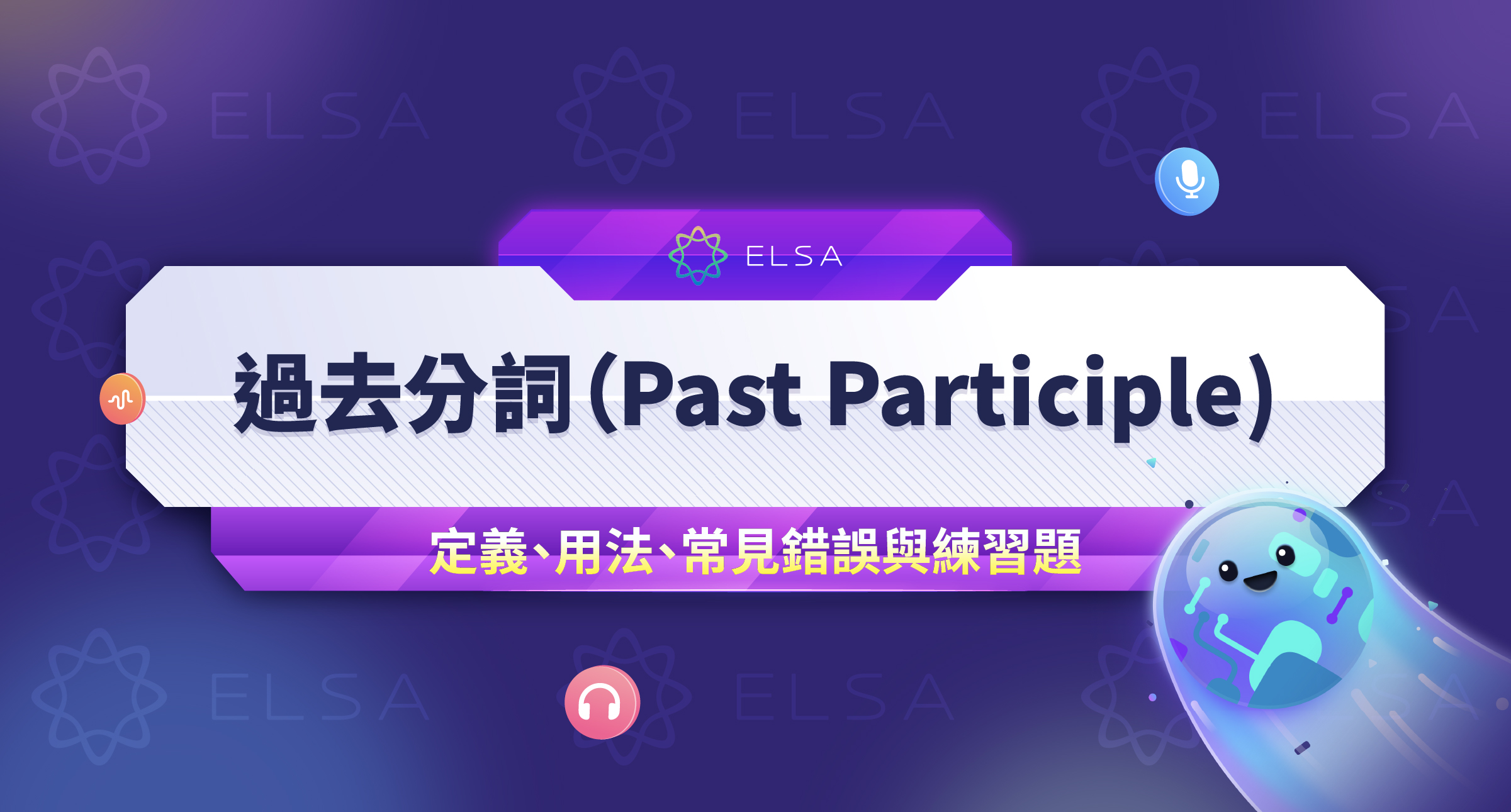
 2025年/07月/28日 | 魚丸
2025年/07月/28日 | 魚丸
